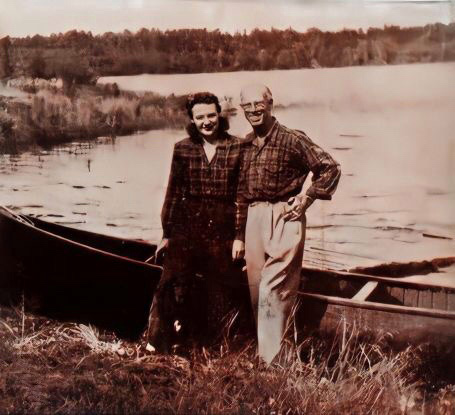by Joan Champ
The following is the seventh installment in a series about Nan Dorland, a radio star from New York City who struggled to become a writer and a prospector in northern Saskatchewan. Follow at www.nandorland.blogsot.com or on Instagram @discoveringnan
It took Nan and Richard Morenus five days to travel from Manhattan to Sioux Lookout, Ontario. They were granted permanent entry into Canada at the Pigeon River, Ontario border crossing on May 4, 1941.
Their first stop in Sioux Lookout was the Hollywood Cafe owned by Tom and Ken Lee where they ate lunch “under the questioning gaze of Indians and bushmen,” Richard writes in his September 1, 1946 article for Maclean’s magazine, “From Broadway to Bush.” They were obviously “those crazy Americans” who had bought the island and were moving there to live. “That’s something you’ll have to get used to,” Ken Lee told Richard. “You’re something of a curiosity. It isn’t every day that an American, especially a New Yorker, comes to the bush to live.”
The couple was ferried over to the island where their cabin, about 100 feet inland from shore, was nestled in a stand of birch. Their first task was to repair the cabin. The log walls were solid and in good condition, but the windows needed new casements and screens, the doors needed to be refitted, and the roof, which leaked in at least a dozen places, had to be fixed. Blankets had to be mended and mattresses patched. Firewood had to be sawed, split and piled before winter.
By October of 1941, they had things in good shape. Their 18’ x 20’ cabin was partitioned into three sections: a kitchen-dining-office-living space; a bedroom with closet; and a food storage-wash room. At the end of the kitchen room were bookshelves and a table they used as a desk. Homemade rag rugs covered the floor.
“Up to our arrival the hardest work Nan had done was to hold a script in soft, well-manicured hands and stand before a microphone,” Richard observes.” But by that October sore and painful blisters had developed into work-toughened calluses.”
Richard asked Nan if she missed New York. “This isn’t half as bad as trying to get a part on Broadway, or auditioning for a new radio show,” Nan replied. “That’s work. This is the bush, and I love it. This is fun. Now come on, we’ll just have time to get in the last of that red pine we sawed up. That mallard I shot’s in the oven. We’re having it for supper, and can you get that on 6th Avenue?”
Nan soon learned to set snares, augmenting their venison fare with rabbit stew. She made bannock and baked bread. Within a year, Nan could hunt her own deer and skin it herself. She could repair her snowshoes, weaving a new babiche from deer hide.
“When will we go back?” Richard asked Nan. “My moccasins are soft on my feet when I walk in the woods,” she replied. “I’d miss my canoe. My dog team would be lonesome if I should leave them. I have more freedom than anyone else in the world. And where else is there anything so beautiful. Go back? Go back to what? I have nothing to go back to. I’m where I belong now. I’m home!”
Contact: joanchamp@shaw.ca


